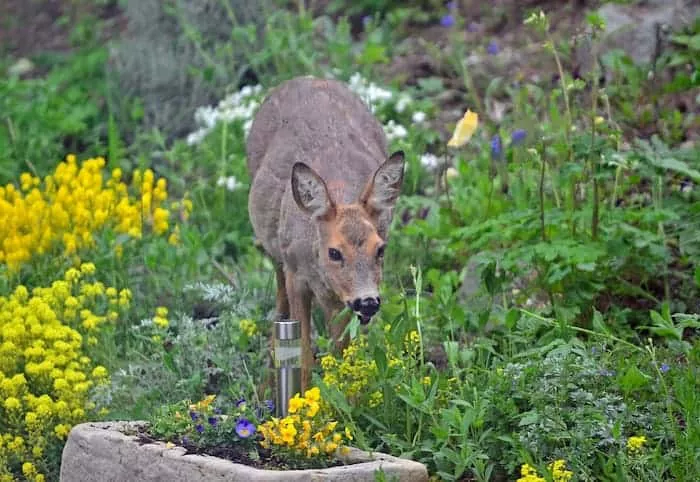Deer are beautiful creatures, but they can be a significant challenge for gardeners and homeowners. Their appetite for plants can lead to damaged gardens and landscapes. Fortunately, there are certain plants that deer tend to avoid due to their taste, scent, or texture. In this article, we’ll explore what plants deer stay away from, why they avoid them, and how you can use these plants to protect your garden from deer damage.
Why Do Deer Avoid Certain Plants?
Strong Scents
Deer have a keen sense of smell, and they are often repelled by plants with strong, pungent aromas. These scents can mask the smell of more appealing plants and make the area less attractive to deer.
Bitter or Toxic Compounds
Some plants contain chemicals that are bitter or toxic to deer. These compounds make the plants unpalatable and discourage deer from eating them.
Texture and Toughness
Plants with fuzzy, prickly, or tough leaves are less appealing to deer. They prefer tender, soft foliage, so plants with coarse textures are often left alone.
Plants That Deer Avoid
1. Lavender (Lavandula spp.)
Why Deer Avoid It
Lavender has a strong, aromatic scent that deer find unpleasant. Its fragrance is calming for humans but acts as a natural repellent for deer.
How to Use It
- Plant lavender around garden borders or near vulnerable plants.
- Use dried lavender in sachets to deter deer from specific areas.
2. Rosemary (Rosmarinus officinalis)
Why Deer Avoid It
Rosemary has a strong, woody scent and tough, needle-like leaves that deer dislike.
How to Use It
- Grow rosemary in sunny areas of your garden.
- Use rosemary sprigs as a natural repellent by placing them around your garden.
3. Mint (Mentha spp.)
Why Deer Avoid It
Mint has a strong, refreshing scent that deer find overwhelming. The essential oils in mint, such as menthol, act as natural repellents.
How to Use It
- Plant mint in containers to prevent it from spreading.
- Use crushed mint leaves as a natural repellent.
4. Daffodils (Narcissus spp.)
Why Deer Avoid It
Daffodils contain toxic compounds called alkaloids, which make them unpalatable to deer.
How to Use It
- Plant daffodils in clusters around your garden.
- Use them as a border plant to protect more vulnerable species.
5. Marigolds (Tagetes spp.)
Why Deer Avoid It
Marigolds have a strong, pungent scent that deer dislike. They also contain pyrethrin, a natural insect repellent.
How to Use It
- Plant marigolds around vegetable gardens or flower beds.
- Use marigold flowers in bouquets to keep deer away.
6. Foxglove (Digitalis purpurea)
Why Deer Avoid It
Foxglove contains cardiac glycosides, which are toxic to deer and other animals.
How to Use It
- Plant foxglove in shaded areas of your garden.
- Use it as a natural barrier to protect other plants.
7. Russian Sage (Perovskia atriplicifolia)
Why Deer Avoid It
Russian sage has a strong, aromatic scent and fuzzy leaves that deer find unappealing.
How to Use It
- Plant Russian sage in sunny, well-drained areas.
- Use it as a border plant to deter deer.
8. Lamb’s Ear (Stachys byzantina)
Why Deer Avoid It
Lamb’s ear has soft, fuzzy leaves that deer dislike. The texture makes it unappealing for them to eat.
How to Use It
- Plant lamb’s ear in sunny or partially shaded areas.
- Use it as a ground cover to protect other plants.
9. Yarrow (Achillea millefolium)
Why Deer Avoid It
Yarrow has a strong, bitter taste and a pungent scent that deer avoid.
How to Use It
- Plant yarrow in sunny, well-drained areas.
- Use it as a natural repellent in flower beds or borders.
10. Boxwood (Buxus spp.)
Why Deer Avoid It
Boxwood has tough, leathery leaves and a strong scent that deer find unappealing.
How to Use It
- Plant boxwood as a hedge or border plant.
- Use it to create a natural barrier around your garden.
How to Use These Plants Effectively
Create a Deer-Resistant Garden
Incorporate deer-resistant plants into your garden design. Use them as borders, ground covers, or focal points to protect more vulnerable plants.
Combine Plants
Mixing different deer-resistant plants can enhance their effectiveness. For example, combine lavender, rosemary, and marigolds for a multi-layered defense.
Use in High-Risk Areas
Place deer-resistant plants near entry points, such as fences or gates, to deter deer from entering your garden.
Regular Maintenance
Trim and maintain deer-resistant plants to ensure they release their scents effectively. Crush leaves occasionally to release more oils.
Other Tips to Deter Deer
Fencing
Install a tall fence (at least 8 feet high) around your garden to keep deer out. Electric fences can also be effective.
Repellents
Use commercial or homemade deer repellents. These can be sprayed on plants to make them less appealing to deer.
Scare Tactics
Use motion-activated sprinklers, noise makers, or scarecrows to frighten deer away from your garden.
Common Questions About Deer and Plants
Do These Plants Harm Deer?
Most deer-resistant plants simply deter deer without harming them. However, some plants, like foxglove, can be toxic if ingested in large quantities.
Can I Use Essential Oils Instead of Plants?
Yes, essential oils from plants like lavender, rosemary, and mint can be used as natural repellents. Mix a few drops with water and spray around your garden.
How Long Do Deer-Resistant Plants Last?
The effectiveness of deer-resistant plants depends on their growth and maintenance. Regularly trimming and crushing leaves can help maintain their repellent properties.
Conclusion
Deer can be a significant challenge for gardeners, but planting deer-resistant species can help protect your garden from damage. Lavender, rosemary, mint, daffodils, marigolds, foxglove, Russian sage, lamb’s ear, yarrow, and boxwood are all effective at deterring deer due to their strong scents, bitter tastes, or tough textures.
By incorporating these plants into your garden and using additional deterrents like fencing and repellents, you can create a deer-resistant landscape that thrives. With a little planning and effort, you can enjoy a beautiful, deer-free garden. Happy gardening!


